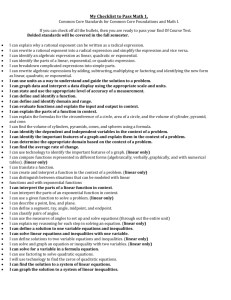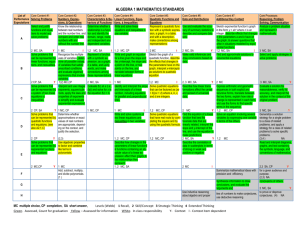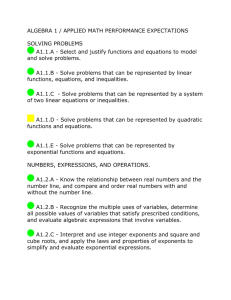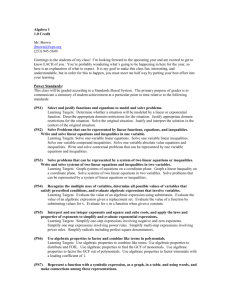August 22, 2008 page 1 Self-Assessment: Algebra 1 On a scale of 5
advertisement
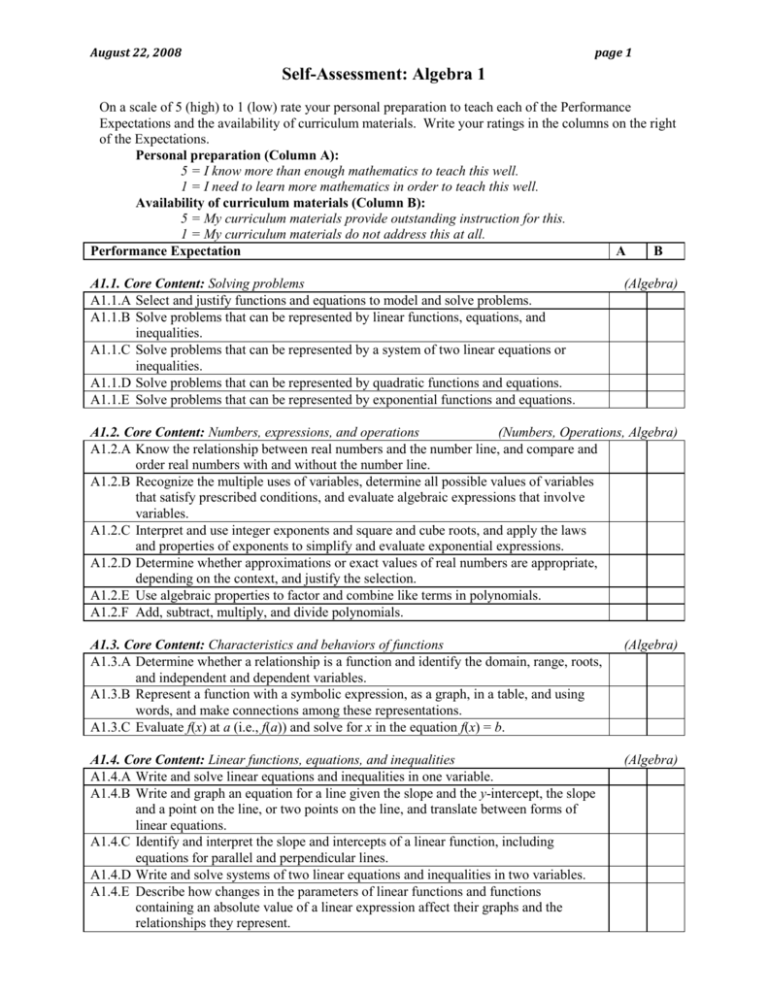
August 22, 2008 page 1 Self-Assessment: Algebra 1 On a scale of 5 (high) to 1 (low) rate your personal preparation to teach each of the Performance Expectations and the availability of curriculum materials. Write your ratings in the columns on the right of the Expectations. Personal preparation (Column A): 5 = I know more than enough mathematics to teach this well. 1 = I need to learn more mathematics in order to teach this well. Availability of curriculum materials (Column B): 5 = My curriculum materials provide outstanding instruction for this. 1 = My curriculum materials do not address this at all. Performance Expectation A B A1.1. Core Content: Solving problems A1.1.A Select and justify functions and equations to model and solve problems. A1.1.B Solve problems that can be represented by linear functions, equations, and inequalities. A1.1.C Solve problems that can be represented by a system of two linear equations or inequalities. A1.1.D Solve problems that can be represented by quadratic functions and equations. A1.1.E Solve problems that can be represented by exponential functions and equations. (Algebra) A1.2. Core Content: Numbers, expressions, and operations (Numbers, Operations, Algebra) A1.2.A Know the relationship between real numbers and the number line, and compare and order real numbers with and without the number line. A1.2.B Recognize the multiple uses of variables, determine all possible values of variables that satisfy prescribed conditions, and evaluate algebraic expressions that involve variables. A1.2.C Interpret and use integer exponents and square and cube roots, and apply the laws and properties of exponents to simplify and evaluate exponential expressions. A1.2.D Determine whether approximations or exact values of real numbers are appropriate, depending on the context, and justify the selection. A1.2.E Use algebraic properties to factor and combine like terms in polynomials. A1.2.F Add, subtract, multiply, and divide polynomials. A1.3. Core Content: Characteristics and behaviors of functions A1.3.A Determine whether a relationship is a function and identify the domain, range, roots, and independent and dependent variables. A1.3.B Represent a function with a symbolic expression, as a graph, in a table, and using words, and make connections among these representations. A1.3.C Evaluate f(x) at a (i.e., f(a)) and solve for x in the equation f(x) = b. (Algebra) A1.4. Core Content: Linear functions, equations, and inequalities A1.4.A Write and solve linear equations and inequalities in one variable. A1.4.B Write and graph an equation for a line given the slope and the y-intercept, the slope and a point on the line, or two points on the line, and translate between forms of linear equations. A1.4.C Identify and interpret the slope and intercepts of a linear function, including equations for parallel and perpendicular lines. A1.4.D Write and solve systems of two linear equations and inequalities in two variables. A1.4.E Describe how changes in the parameters of linear functions and functions containing an absolute value of a linear expression affect their graphs and the relationships they represent. (Algebra) August 22, 2008 page 2 A1.5. Core Content: Quadratic functions and equations A1.5.A Represent a quadratic function with a symbolic expression, as a graph, in a table, and with a description, and make connections among the representations. A1.5.B Sketch the graph of a quadratic function, describe the effects that changes in the parameters have on the graph, and interpret the x-intercepts as solutions to a quadratic equation. A1.5.C Solve quadratic equations that can be factored as (ax + b)(cx + d) where a, b, c, and d are integers. A1.5.D Solve quadratic equations that have real roots by completing the square and by using the quadratic formula. (Algebra) A1.6. Core Content: Data and distributions (Data/Statistics/Probability) A1.6.A Use and evaluate the accuracy of summary statistics to describe and compare data sets. A1.6.B Make valid inferences and draw conclusions based on data. A1.6.C Describe how linear transformations affect the center and spread of univariate data. A1.6.D Find the equation of a linear function that best fits bivariate data that are linearly related, interpret the slope and y-intercept of the line, and use the equation to make predictions. A1.6.E Describe the correlation of data in scatterplots in terms of strong or weak and positive or negative. A1.7. Additional Key Content A1.7.A Sketch the graph for an exponential function of the form y = abn where n is an integer, describe the effects that changes in the parameters a and b have on the graph, and answer questions that arise in situations modeled by exponential functions. A1.7.B Find and approximate solutions to exponential equations. A1.7.C Express arithmetic and geometric sequences in both explicit and recursive forms, translate between the two forms, explain how rate of change is represented in each form, and use the forms to find specific terms in the sequence. A1.7.D Solve an equation involving several variables by expressing one variable in terms of the others. A1.8. Core Processes: Reasoning, problem solving, and communication A1.8.A Analyze a problem situation and represent it mathematically. A1.8.B Select and apply strategies to solve problems. A1.8.C Evaluate a solution for reasonableness, verify its accuracy, and interpret the solution in the context of the original problem. A1.8.D Generalize a solution strategy for a single problem to a class of related problems, and apply a strategy for a class of related problems to solve specific problems. A1.8.E Read and interpret diagrams, graphs, and text containing the symbols, language, and conventions of mathematics. A1.8.F Summarize mathematical ideas with precision and efficiency for a given audience and purpose. A1.8.G Synthesize information to draw conclusions, and evaluate the arguments and conclusions of others. A1.8.H Use inductive reasoning about algebra and the properties of numbers to make conjectures, and use deductive reasoning to prove or disprove conjectures. (Algebra)





